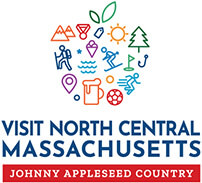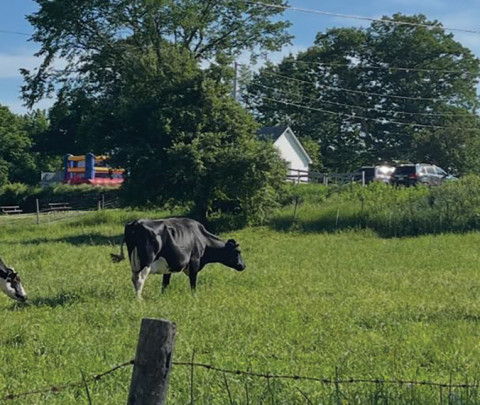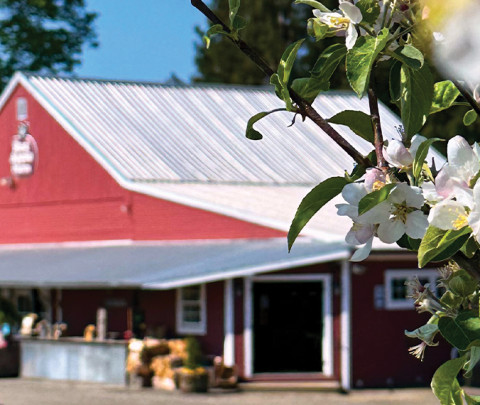It’s a Wild, Wild World
- Visit North Central
Look Who’s Living in Johnny’s Backyard!
Although known for its orchards — and its seed-sowing namesake — there’s more to Johnny Appleseed Country than fertile farms and taste-tempting farmstands.
With a wealth of protected land and a variety of natural habitats, North Central Massachusetts is prime wildlife country. The region is home to thriving populations of species such as moose, black bears, white-tailed deer, beavers, bald eagles, common loons, and great blue herons.
Not long ago, many of these creatures were absent from the area, thanks to habitat loss and unregulated hunting in historic times. However, the regrowth of forests and conservation efforts have allowed these species to return in recent decades. Moose, for example, have become increasingly common over the past 25 years. Another success story is the bald eagle, which was successfully reintroduced at Quabbin Reservoir during the 1980s.
Where to Begin
While all of the region’s trails have viewing potential, the most productive wildlife areas have diverse habitats, such as wetlands, meadows, and forests of mixed ages. The best time for viewing is generally early and late in the day, when many animals and birds are most active. Winter offers the opportunity to observe tracks and sign that offer insight into the activities of otherwise-elusive animals.
Quabbin Reservoir, which was built as Boston’s water supply during the 1930s, is home to a wide variety of wildlife. It has served as a reintroduction area for bald eagles, wild turkeys, and beavers, and hosts a dozen pairs of breeding common loons and a growing moose population.
One of the best viewing trails is the old road to Dana Common (Gate 40) in Petersham, which passes old fields and Potapaug Pond en route to the Dana Common historic site.
Long Pond and the Tully River, which are part of the Tully Lake flood-control watershed in Royalston, offer viewing opportunities for paddlers and hikers. The river’s resident beavers often swim close by boats, and turtles, river otters, wading birds and dragonflies are also common. Though more elusive, moose and black bears also frequent the area. A boat launch and foot/bike trails are located on Doane Hill Road across from the Tully Lake Campground.
Lively Waterways
The Otter River State Forest, Birch Hill Wildlife Management Area, and Lake Dennison Recreation Area protect more than 20,000 acres of wetlands and forests along the Millers and Otter Rivers and Priest Brook. Watch for beavers, river otters, mink, and green and blue herons in the ponds and beaver wetlands. This expansive area is reached via Route 202 north of Baldwinville or Route 68 at Birch Hill Dam in South Royalston.
Mass Audubon’s Lake Wampanoag Wildlife Sanctuary in Gardner features large meadows and an old farm pond bordered by forests. The fields are home to a variety of butterflies and uncommon grassland birds such as bluebirds and bobolinks. Porcupines and other animals often feed in the old apple trees near the entrance. The nearby High Ridge Wildlife Management Area on Route 140 in Westminster includes farm fields, a pond, and nesting boxes used by bluebirds and tree swallows.
Several conservation areas protect more than 20,000 acres of the Ware River watershed in Hubbardston and Barre. The habitats include swamps, beaver ponds, and large meadows. This area is home to a large moose population and is an outstanding place to see woodcock, songbirds, and migrating hawks. Many of the dirt roads, which can be accessed from the Barre Falls Dam recreation area off Route 62, are open seasonally to vehicles.
Learn as You Go
Another Mass Audubon property with outstanding diversity is Wachusett Meadows Wildlife Sanctuary in Princeton. A well-marked 12-mile trail network leads to large meadows and old pastures, ponds, hills, and an abandoned beaver wetland. The sanctuary offers many educational programs throughout the year.
The Rocky Hill Wildlife Sanctuary, also owned by Mass Audubon, is part of a 2,500-acre corridor of protected land in Groton and Ayer. The Rookery Trail leads to a beaver pond with a large blue heron colony. Other habitats include vernal pools and rocky outcroppings.
In Harvard, the Oxbow National Wildlife Refuge encompasses a series of wetlands in the floodplain of the Nashua River. An easy 1.7-mile interpretive loop trail offers fine views of the river, a beaver lodge, several ponds, and a brushy field. A short side trail leads to a wooden observation blind on the edge of a beaver pond.
Lace up you boots, grab a camera, and explore the wild side of Johnny’s backyard!
photos courtesy of John Burk








